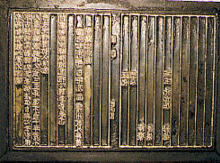[FOX SCI-FAIR] The Science of spreading knowledge
 •
by
•
by Lisamunusira

To spread knowledge books do help a lot. To get books a printing device is very useful.
The history of printing goes back to the duplication of images by means of stamps in very early times. The use of round seals for rolling an impression into clay tablets goes back to early Mesopotamian civilization before 3000 BCE, they feature complex and beautiful images. In both China and Egypt, the use of small stamps for seals preceded the use of larger blocks. In China, India and Europe, printing on cloth certainly preceded printing on paper or papyrus. The process is essentially the same: in Europe special presentation impressions of prints were often printed on silk until the 17th century. The development of printing has made it possible for books, newspapers, magazines, and other reading materials to be produced in great numbers, and it plays an important role in promoting literacy.

Movable type (1041)
Movable-type was invented in the Northern Song dynasty around the year 1041 by the commoner Bi Sheng. Bi Sheng's movable-type was fired in porcelain. After his death, the ceramic movable-type passed onto his descendants. The next mention of movable-type occurred in 1193 when a Southern Song chief counselor, Zhou Bida (周必大), attributed the movable-type method of printing to Shen Kuo. However Shen Kuo did not invent the movable-type but credited it to Bi Sheng in his Dream Pool Essays. The ceramic movable-type was also mentioned by Kublai Khan's councilor Yao Shu, who convinced his pupil Yang Gu to print language primers using this method.
The most widespread use of metal movable type occurred in Korea, where its methods were understood sometime before 1232 under the Goryeo Dynasty.[37] The oldest known book to have been printed using movable metal type is the Sangjeong Gogeum Yemun of 1232, by Choe Yun-ui.[38] However, all 50 original copies seem to have been lost. The oldest extant book printed with movable metal type is the Jikji of 1377.
Europe was later
Cast metal movable type may have spread to Europe between the late 14th and early 15th centuries.
It is traditionally surmised that Johannes Gutenberg, of the German city of Mainz, developed European movable type printing technology with the printing press around 1439 and in just over a decade, the European age of printing began. However, the evidence shows a more complex evolutionary process, spread over multiple locations. Also, Johann Fust and Peter Schöffer experimented with Gutenberg in Mainz.

Compared to woodblock printing, movable type page-setting was quicker and more durable. The metal type pieces were more durable and the lettering was more uniform, leading to typography and fonts. The high quality and relatively low price of the Gutenberg Bible (1455) established the superiority of movable type, and printing presses rapidly spread across Europe, leading up to the Renaissance, and later all around the world. Today, practically all movable type printing ultimately derives from Gutenberg's movable type printing, which is often regarded as the most important invention of the second millennium.
Education has two sides
As books could be made fast and in large quantities more and more people began to read and discuss ideas. Society in Europe improved very fast because of this. However the other side of the medal was that people that rebelled could spread their ideas faster than the rulers could stopped them. The more or less religious unity of Catholicism fell apart.

Europe is making war
In Central, Western and Northern Europe from 1524 to 1648 many wars following the onset of the Protestant Reformation in Europe.

The Thirty Years' War was a war fought primarily in Central Europe between 1618 and 1648. One of the longest and most destructive conflicts in human history, as well as the deadliest European religious war in history, the war resulted in eight million fatalities. The Thirty Years' War devastated entire regions, with famine and disease resulting in high mortality in the populations of the German and Italian states, the Crown of Bohemia, and the Southern Netherlands. Both mercenaries and soldiers in fighting armies traditionally looted or extorted tribute to get operating funds, which imposed severe hardships on the inhabitants of occupied territories. The war also bankrupted most of the combatant powers.
Literacy as a human right
Literacy is a human right essential for lifelong learning and social change. As supported by the 1996 Report of the International Commission on Education for the Twenty-First Century, and the 1997 Hamburg Declaration: ‘Literacy, broadly conceived as the basic knowledge and skills needed by all in a rapidly changing world, is a fundamental human right. (...) There are millions, the majority of whom are women, who lack opportunities to learn or who have insufficient skills to be able to assert this right. The challenge is to enable them to do so. This will often imply the creation of preconditions for learning through awareness raising and empowerment. Literacy is also a catalyst for participation in social, cultural, political and economic activities, and for learning throughout life’.

To read a lot, to learn a lot and to work together is the way forward!


Comments
If you are interested in book pressing technology through history I recommend
http://www.museumplantinmoretus.be/en
The Plantin Moretus museum
Looks like a really nice place to visit 🙂
Awesome!
Thank you 🙂
v
Ouch, it seems literacy and knowledge spread the wars.
It did, but knowledge also brought us prosperity
I would argue that illiteracy and ignorance have caused far more wars 😉
There is so much what causes wars. I do hope good education will prevent wars.
We owe a lot to the invention of the printing press
Long live Gutenberg!
https://www.gutenberg.org
o7
Very nice...o/
Loved it!
❤
I liked the articrle
popo, nice nice!
Great article. Very enjoyable read